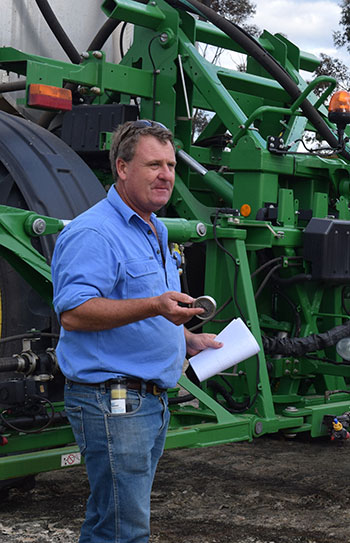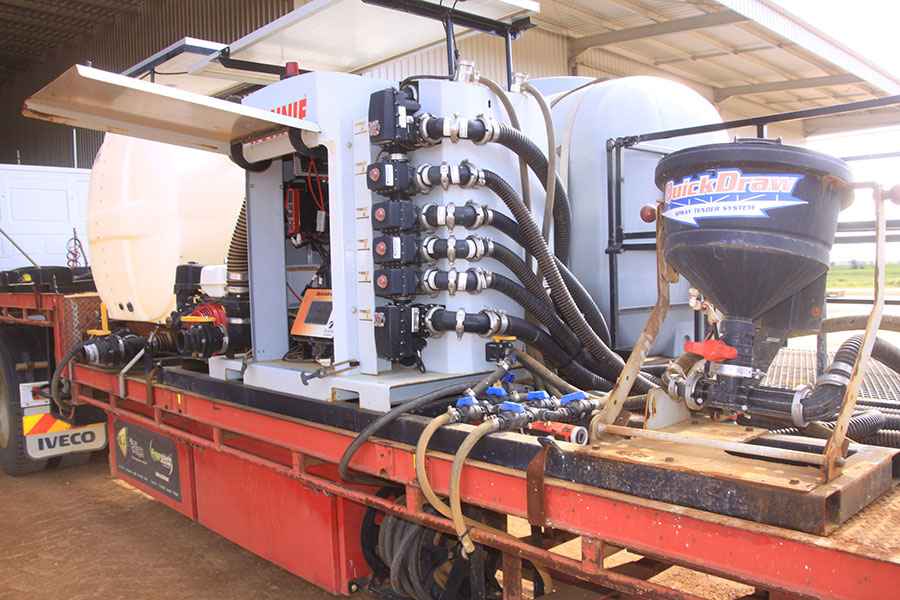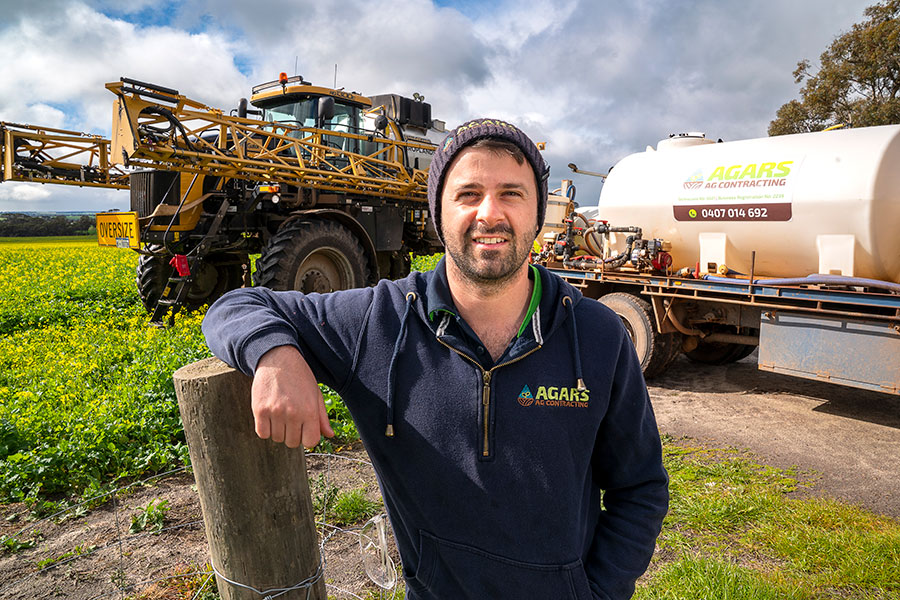Key points
- Make time to assess system and property requirements to look for efficiencies
- There are a number of ways to achieve efficiencies
- The biggest efficiency gain can be in the ferry and fill component
- It is important to understand the chemicals you are using
- While considering efficiency gains, also look for ways to reduce risk to operators
What started with a peer-to-peer spray application workshop has culminated in a technical guide for mixing and batching of agricultural chemicals for growers: an example of the flexibility of GRDC’s National Grower Network-directed investments.
“We anticipate the mixing and batching booklet will become a valuable reference resource for growers for years to come,” says Western Australian spray application specialist Bill Campbell.
Mr Campbell, who convened the workshops, was instrumental in pulling the guidebook together, along with Elizabeth von Perger, a former GRDC grower relations manager who is now chief executive officer at Stirlings to Coast Farmers.
 Bill Campbell presenting at one of the GRDC National Grower Network-initiated spray workshops in WA in 2020. Photo: Mae Connolly
Bill Campbell presenting at one of the GRDC National Grower Network-initiated spray workshops in WA in 2020. Photo: Mae Connolly
The guidebook showcases the day-to-day practicalities with grower case studies for various enterprise sizes, each bringing different concepts, ideas and creative engineering to spray operations. Growers and spray contractors from across Australia are highlighted.
Spraying efficiency is about maximising hectares sprayed in a day. Carefully analysing each step in a spray operation can identify where efficiencies can be gained, and there are a number of ways in which efficiencies can be achieved.
In this respect, the ‘fill and ferry’ or the ‘pit-stop’ step has been identified by spray operators as the stage where significant efficiencies can be made. Mixing and batching of chemicals is a key part of the fill component.
“The guidebook also contains important information on chemical formulations and the correct mixing order, with a summary provided covering common agricultural chemical formulations together with a brief overview of common mishaps that can occur and tips on how to avoid them. Fastest is definitely not always the best when it comes to mixing chemicals,” Mr Campbell says.
Background
In early 2020, a series of GRDC sprayer calibration and application workshops commenced across the WA grainbelt, delivered by Mr Campbell. Seventeen full-day workshops have been delivered, with three remaining to be run in 2023. The workshops particularly catered for the needs of younger grain growers, growers with new machinery and farm employees.
“The spray workshops were a great example of how the GRDC’s National Grower Network operates,” says GRDC grower relations manager Jo Wheeler.
The network has been established to support meaningful engagement with grain growers, improve understanding of local issues and assist in the development of investments that are locally relevant and have on-farm impact. Industry forums such as these are a key means to provide learning events.
“People attending these free, on-farm events are updated on current best-practice spraying information to enable them to make correct and effective decisions across different spray situations.”
On show at the workshops are a number of different spraying systems and technologies, to demonstrate correct procedures for mixing and batching chemicals.
As this step in the spraying process has been identified as the one where significant efficiencies can be made, growers expressed interest in having a manual developed to document issues to do with mixing and batching and to learn from the grower machinery case studies.
Mixing and batching
Tank-mixing agricultural chemicals is a routine procedure that can reduce application costs, enhance certain products’ activity and widen the range of treatments in a single application, therefore improving efficiency of spray operations. However, mixing must be approached carefully so that there are no antagonisms interfering with the efficacy of various components, synergisms that cause crop damage or chemical reactions creating unsprayable sludge.
“Always follow label recommendations and check product compatibility and manufacturers mixing guidelines,” Mr Campbell says.
Always use good-quality water and consider using an adjuvant to improve the physical compatibility of certain tank mixes.
“When mixing a batch for the first time, conduct a jar test that replicates the tank mix. This will reduce the risk of financial losses and time-consuming and environmentally unfavourable situations, in cases where the mix doesn’t turn out as intended.”
The guidebook includes details on chemical formulations, adjuvant types and mixing orders, together with common issues to consider for each type. These chemicals may be wettable powders, water-dispersible granules, dry flowables, flowables, emulsifiable concentrates and aqueous concentrate or soluble liquids.
“Products or active ingredients that are the most difficult to disperse/dissolve, or require the most time, are generally added first to the spray tank,” Mr Campbell says.
As mixing and batching errors can result in the formation of ‘glugs’ and gluey residues, oily creams and excessive foam that can block filters and nozzles, the guidebook includes a troubleshooting section documenting what can go wrong and how to avoid these situations.
Necessity drives innovation
Every farming operation is different, so it is important to match spray capacity with the needs of your farming operation and to understand any limitations. There must be sufficient capacity – both labour and equipment – to spray in a timely manner with the allowance of downtime due to weather conditions (wind, rain, heat), drift considerations or physical logistics (shifting sprayers or equipment, moving chemicals).
These necessities drive the innovations required to customise mixing and batching macHinesry for each business.
Figure 1: Examples of the innovative set-ups developed by growers to improve efficiency and safety of chemical mixing and batching

Photos: Bill Campbell
“Size of properties being serviced and labour availability drives many of these modifications growers
are making,” Mr Campbell says.
The case studies included in the guidebook cover a range of operation sizes (both grower and contractor) and crop mixes in different rainfall zones. They explore the individual requirements - such as farm infrastructure, equipment and staff management - required to service their spray operations.
The guidebook also collates innovative ideas from both growers and spray contractors for building and setting up equipment for agrochemical mixing and batching operations. Often these modifications are done with occupational health and safety issues at top of mind.
Case study snapshots
Four grower case studies and three spray contractor case studies are included in the Guidebook. Following are snapshots of a selection of these.
Matt Hill and Mick Young – ‘Young Hill Farms’, Beaumont/Esperance
Matt and Mick estimate that they spray between 77,500 and 93,000 hectares a year over two separate blocks – one 13,000ha and the other 2600ha. Thinking through their property layout and fill locations, and investing in quality equipment and storage, has boosted their spray efficiency.
 The SureFire QuickDraw computerised, pre-programed batching system used by Matt Hill and Mick Young avoids the need to manually measure agricultural chemicals but is only suited to liquids. Photo: Bill Campbell
The SureFire QuickDraw computerised, pre-programed batching system used by Matt Hill and Mick Young avoids the need to manually measure agricultural chemicals but is only suited to liquids. Photo: Bill Campbell
To execute their spray program, they have two dedicated spray operators doing the mixing, batching and filling, and one support staff setting up, shifting and stocking the chemical trailer. They have 12 100,000-litre tanks running off solar pumps, located strategically so that each tank covers more than 2000ha. The average distance to fill points is 500 metres. They use flowable or liquid formulations wherever possible as these are the only forms that can be handled with minimal physical contact with their SureFire automated mixing system.
They have learnt to maximise their spray efficiency to work sprayers in adjacent paddocks for easy access to refill.
Phil and Tom Longmire, East Esperance
Phil and Tom farm 5700ha over six properties and spray an estimated 40,000ha each year. To improve the efficiency of their operations they work as a tag team, with one operating as the mixer and batcher for the other spray operator. Mixing and batching for each other is a significant time gain as otherwise they would have to wait for chemical granules to mix and disperse.
 Tom Longmire with his farm’s flat-top Curtainsider truck and trailer, which has two 870L-capacity batch-induction systems. Photo: Evan Collis
Tom Longmire with his farm’s flat-top Curtainsider truck and trailer, which has two 870L-capacity batch-induction systems. Photo: Evan Collis
They have invested in a flat-top tautliner Curtainsider truck with tri-axle trailer, which holds the complete mix and batch set-up, including three independent measuring and batching systems. The trailer holds two Handler IV 870L-capacity batch-induction systems. An additional dual-axle trailer can be hooked up as a third batch-and-fill station, holding 2 x 1000L Intermediate Bulk Container shuttles and three 110L envirodrums.
The truck contains three cone-bottom measuring vessels (2 x 200L and 1 x 100L), all fitted with Sotera chemical induction pumps on their own independent circuit, thus avoiding cross-contamination for smaller-volume products (for example, grass-selective herbicides, insecticides or adjuvants).
Haiden Agars – Spray contractor
As a one-sprayer contractor covering a large area and often dealing with small, undulating paddocks, Haiden’s batching set-up mounted on a rigid truck allows him to move quickly between clients and squeeze into corners of paddocks with ease.
It has been designed so there is no lost spraying time – the truck ferries chemical mixes to the sprayer and is easily able to refill and batch the next chemical mix between sprayer loads, minimising mistakes.
Occupational health and safety considerations are maximised by incorporating ground-level access to the granny pot, taps and connections so the operator does not have to climb onto the truck.
 As a single-operator spray contractor, Haiden Agars has opted for a mixing and batching set-up mounted on a rigid truck that allows him to move quickly between clients and squeeze into corners of paddocks with ease. Photo: Evan Collis
As a single-operator spray contractor, Haiden Agars has opted for a mixing and batching set-up mounted on a rigid truck that allows him to move quickly between clients and squeeze into corners of paddocks with ease. Photo: Evan Collis
The set-up incorporates 1000L of water storage on the truck, as some clients do not have the necessary water infrastructure for refill, and allows for thorough decontamination (every part of the system in contact with chemical - including the sprayer - is flushed with water and All ClearÒ DS prior to moving to the next client).
Mr Campbell says the workshops formed a great basis to glean the information for the technical guide.
“Peer-to-peer learning events such as the spray workshops are an important way to share learning across the industry. They start conversations and ignite further inspiration to develop resources to ensure industry needs are being met,” he says.
There is a lot of technical information in the guidebook, much of it presented in tabular form, making it is easy to cross-reference between the case studies. It is available from GRDC’s website.
Aspects to consider to identify efficiency gains for mixing and batching agricultural chemicals:
- water availability – travelling to and from a water source wastes time;
- labour availability;
- farm size and layout – the amount of travel time, shifting spray equipment and chemicals;
- spray units – suitability of mixing and batching equipment, size and number of units to suit farm conditions, mobility of the units;
- ease of decontamination; and
- OHS – eye wash/shower/other safety issues should be readily accessible.
More information: Bill Campbell, 0427 545 553, bill@campbellag.com; Jo Wheeler, 0438 292 167, jo.wheeler@grdc.com.au
View Mixing and Batching for Agricultural Chemical Application – Grower Case Studies.

























































